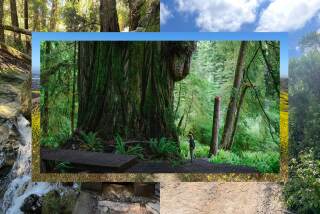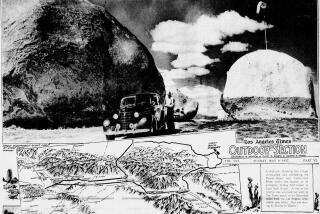Hollywood discovered Guadalupe Dunes decades ago
Reporting from Guadalupe, Calif. — Beneath untold tons of sands, the ancient Egyptian city is no longer intact. But what remains is in good condition. Shielded from the elements by burial, the once-towering monuments to the pharaohs continue to reveal themselves bit by bit.
In recent years, archaeologists -- from professionals to absolute amateurs -- have unearthed various relics. Some of the artifacts are now in a museum. Others are in private collections, such as the sphinx paw on display in John Perry’s auto parts store in Guadalupe, along with the fan belts, headlights and bottles of brake fluid.
“I came to work one morning, and it [the paw] was out in front of my store here,” he says. “One of the employees out there at the dunes years ago probably picked it up and brought it in for me.”
No one’s clamoring for the paw’s return, because it’s not really an Egyptian antiquity. It’s from a film set erected for Cecil B. DeMille’s early epic, “The Ten Commandments.” The location -- Guadalupe Dunes of California’s Central Coast -- remains nearly as isolated and pristine as when the legendary director scouted it in 1923. The dunes are a terrific place to enjoy both raw beauty and a slice of moviemaking history.
Nearly 80 years ago, DeMille’s $1.5-million budget for the silent movie was unheard of. Some of the sets -- made of plaster, straw, and wood -- stood 12 stories tall. A tent city nicknamed Camp DeMille was also erected to house and feed what was literally a cast of thousands.
During the filming, Guadalupe -- a sleepy farming community 90 minutes north of Santa Barbara -- was hopping. Herds of horses and cattle were rented from local farmers, and nearly everyone in town was recruited to play bit parts.
“To them, it was like magic,” says Perry, a 71-year-old Guadalupe native who, as a young man, knew many of the extras.
“Some of them said they would intentionally screw up a scene,” he recalls. “That way, they’d have to work longer and get paid more money. The locals weren’t too dumb.”
The 33-pound plaster paw is just one of Perry’s prized curios.
“They did over 23 movies here in Guadalupe,” he says. His memorabilia includes a staff used by Rudolph Valentino in “The Son of the Sheik” (1926) and various props from “Pirates of the Caribbean: At World’s End” (2007).
The remoteness attracts Hollywood producers, says Mario Castellanos, executive director of the Guadalupe-Nipomo Dunes Center, one of several groups managing the unique ecosystem that covers 18 miles of coastline from Pismo Beach south to Point Sal.
“You see the mountains, you see the coast,” he says. “There’s nothing there to block those views. You don’t see any buildings or other development.”
The Dunes Center, along California Highway 1 in Guadalupe, is the logical starting point for visitors. Located in a restored, 1910 Craftsman home, the free small museum offers a wealth of information about the region’s role in film history, as well as the local ecology.
“We really want people to get a feeling of what it’s like to be in a dunes system,” Castellanos says. “They kind of think the dunes end at the coast, and they don’t realize how far inland [nearly five miles] these coastal dunes go.”
Nestled amid the mounds of sand is Oso Flaco Lake, a freshwater lake that’s an inviting habitat for various types of birds.
“Birding is huge here,” Castellanos says of the flocks of binocular-bearing humans who visit this wayside along the Pacific Flyway. “You have all these migratory birds that come through in March, April and May. You’ll see them here for weeks on end before they move north.”
The dunes that lured DeMille are equally attractive to snowy plovers. From mid-March through September, the small birds nest in the sand, causing park rangers to rope off the area in which the mock Egyptian city was built and later destroyed.
“A lot of it was toppled and sand was pushed back over it,” Castellanos explains. “It was intentionally covered up.”
The explanation for why the sets were buried varies. The Dunes Center director says he’s been told DeMille wanted to keep other movie companies from using his elaborate backdrops. Others say it was simply cheaper to bulldoze the sets than to transport them 175 miles south to Hollywood.
“It is a protected site,” Castellanos says of the ruins of Ramses. “[Rangers] don’t like people picking up items as souvenirs.”
Pieces of plaster and timber aren’t the only curios uncovered by the shifting sand. A number of small, glass bottles -- former cough syrup containers -- have also been revealed. Castellanos says local lore has it that “The Ten Commandments” cast and crew weren’t using the medicine to combat coughing; they were using the alcohol-laced syrup as a tipple during Prohibition.
More to Read
Sign up for The Wild
We’ll help you find the best places to hike, bike and run, as well as the perfect silent spots for meditation and yoga.
You may occasionally receive promotional content from the Los Angeles Times.






